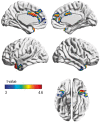The metabolic brain signature of cognitive resilience in the 80+: beyond Alzheimer pathologies
- PMID: 30851100
- PMCID: PMC6439329
- DOI: 10.1093/brain/awz037
The metabolic brain signature of cognitive resilience in the 80+: beyond Alzheimer pathologies
Abstract
Research into cognitive resilience imaging markers may help determine the clinical significance of Alzheimer's disease pathology among older adults over 80 years (80+). In this study, we aimed to identify a fluorodeoxyglucose (FDG)-PET based imaging marker of cognitive resilience. We identified 457 participants ≥ 80 years old (357 cognitively unimpaired, 118 cognitively impaired at baseline, mean age of 83.5 ± 3.2 years) from the population-based Mayo Clinic Study of Aging (MCSA) with baseline MRI, Pittsburgh compound B-PET and FDG-PET scans and neuropsychological evaluation. We identified a subset of 'resilient' participants (cognitively stable 80+, n = 192) who maintained normal cognition for an average of 5 years (2-10 years). Global PIB ratio, FDG-PET ratio and cortical thickness from Alzheimer's disease signature regions were used as Alzheimer's disease imaging biomarker outcomes and global cognitive z-score was used as a cognitive outcome. First, using voxel-wise multiple regression analysis, we identified the metabolic areas underlying cognitive resilience in cognitively stable 80+ participants, which we call the 'resilience signature'. Second, using multivariate linear regression models, we evaluated the association of risk and protective factors with the resilience signature and its added value for predicting global cognition beyond established Alzheimer's disease imaging biomarkers in the full 80+ sample. Third, we evaluated the utility of the resilience signature in conjunction with amyloidosis in predicting longitudinal cognition using linear mixed effect models. Lastly, we assessed the utility of the resilience signature in an independent cohort using ADNI (n = 358, baseline mean age of 80 ± 3.8). Our main findings were: (i) FDG-PET uptake in the bilateral anterior cingulate cortex and anterior temporal pole was associated with baseline global cognition in cognitively stable 80+ (the resilience signature); (ii) established Alzheimer's disease imaging biomarkers did not predict baseline global cognition in this subset of participants; (iii) in the full MCSA 80+ and ADNI cohorts, amyloid burden and FDG-PET in the resilience signature were the stronger predictors of baseline global cognition; (iv) sex and systemic vascular health predicted FDG-PET in the resilience signature, suggesting vascular health maintenance as a potential pathway to preserve the metabolism of these areas; and (v) the resilience signature provided significant information about global longitudinal cognitive change even when considering amyloid status in both the MCSA and ADNI cohorts. The FDG-PET resilience signature may be able to provide important information in conjunction with other Alzheimer's disease biomarkers for the determination of clinical prognosis. It may also facilitate identification of disease targeting modifiable risk factors such as vascular health maintenance.
Keywords: Alzheimer's disease; FDG-PET; amyloid-PET; cognitive reserve; resilience.
© The Author(s) (2019). Published by Oxford University Press on behalf of the Guarantors of Brain. All rights reserved. For Permissions, please email: journals.permissions@oup.com.
Figures





References
-
- Allman JM, Hakeem A, Erwin JM, Nimchinsky E, Hof P. The anterior cingulate cortex. Ann N Y Acad Sci 2001; 935: 107–17. - PubMed
-
- Arenaza-Urquijo EM, Landeau B, La Joie R, Mevel K, Mézenge F, Perrotin A, et al.Relationships between years of education and gray matter volume, metabolism and functional connectivity in healthy elders. Neuroimage 2013; 83: 450–7. - PubMed
Publication types
MeSH terms
Substances
Grants and funding
LinkOut - more resources
Full Text Sources
Other Literature Sources
Medical
Miscellaneous

